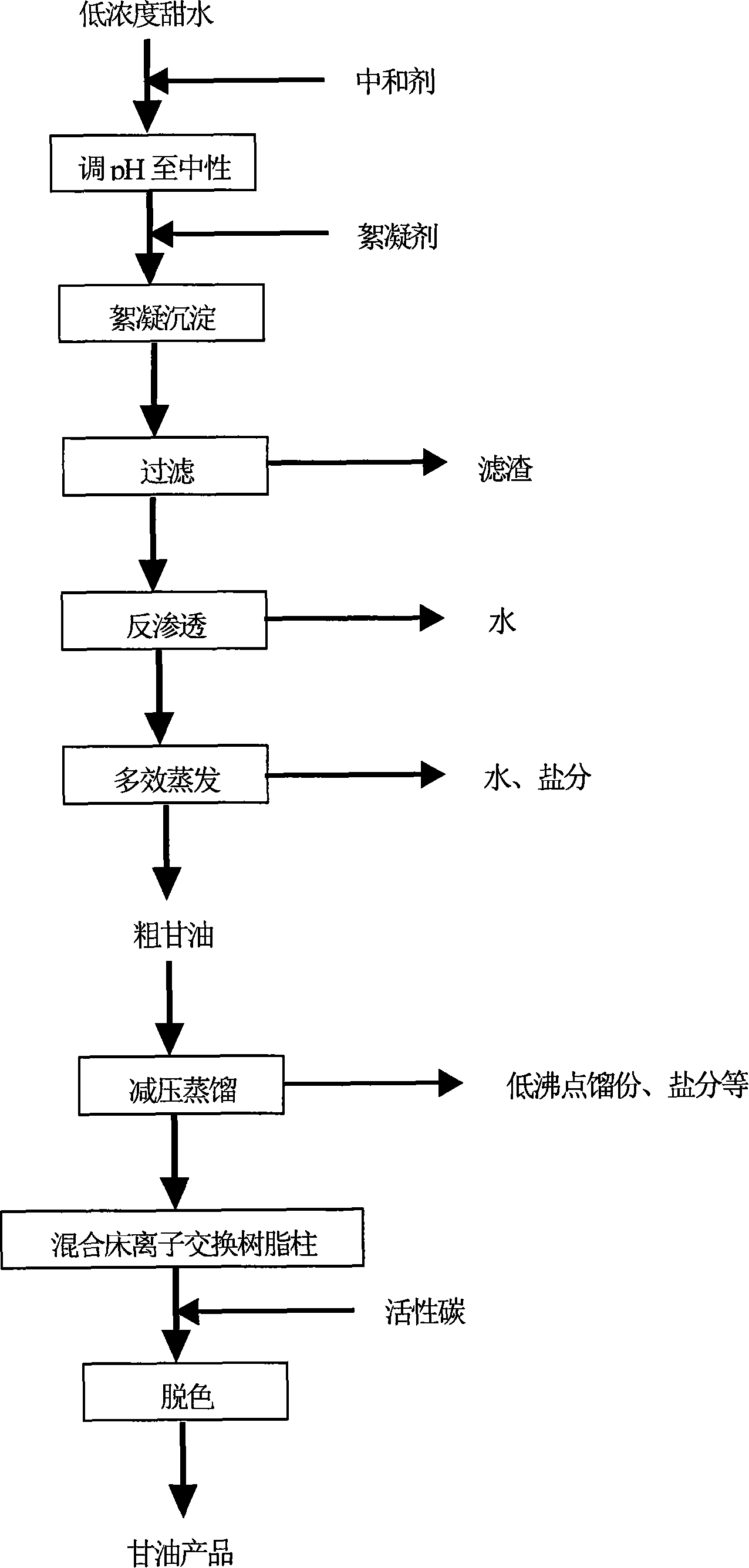Hyperfiltration-distillation integration process for reclaiming glycerin from low-concentration sweet water
A low-concentration, reverse osmosis technology, applied in the field of reverse osmosis-distillation integrated process, can solve the problems of wasting glycerin resources, environmental pollution, difficult to realize self-protection, etc., and achieve the effect of large processing capacity, low energy consumption and low cost
- Summary
- Abstract
- Description
- Claims
- Application Information
AI Technical Summary
Problems solved by technology
Method used
Image
Examples
Embodiment 1
[0031]Take 100kg of acidic sweet water with a glycerol content of 1.1% (mass percentage, the same below), add quicklime to neutralize to neutrality, then add polyferric sulfate, filter after flocculation and precipitation; the filtrate passes through a plate-type cellulose acetate asymmetric membrane under a pressure of 1MPa Component reverse osmosis concentrates to obtain a concentrated solution with a glycerol concentration of 1.4%, and the concentrated solution is subjected to double-effect evaporation to remove water and some salts to obtain crude glycerin; the crude glycerin is purified by vacuum distillation and mixed bed ion exchange resin column at an operating pressure of 2mmHg (201 × 7 type strongly basic styrenic anion exchange resin and 001 × 7 type strongly acidic styrenic cation exchange resin are mixed in a volume ratio of 1: 2) and after active carbon decolorization, 0.88 kg of glycerin product is obtained, and in the product, glycerin The content of 98.6%, the ...
Embodiment 2
[0033] Take 100kg of acidic sweet water with a glycerin content of 2.0%, add sodium hydroxide solution to neutralize to neutrality, then add polyaluminum trichloride, filter after flocculation and precipitation; the filtrate is concentrated by reverse osmosis through a plate polyamide composite membrane module under a pressure of 2MPa Obtain the concentrated solution that glycerol concentration is 3.6%, and the concentrated solution obtains crude glycerin after three-effect evaporation removes water and part salt; Crude glycerin is refined under vacuum distillation, mixed-bed ion-exchange resin column (201 × 7 mmHg) under operating pressure Type strong basic styrenic anion exchange resin and 001 * 7 type strongly acidic styrenic cation exchange resin are mixed by volume ratio 1: 1) and activated carbon decolorize to obtain glycerol product 1.74kg, and the content of glycerol in the product is 98.7% , The recovery rate of glycerol was 85.9%.
Embodiment 3
[0035] Take 100kg of alkaline sweet water with a glycerin content of 1.8%, add sulfuric acid solution to neutralize it to neutrality, then add alum, flocculate and precipitate, and filter; the filtrate is concentrated under a pressure of 3 MPa by reverse osmosis through a plate-type polybenzimidazolone membrane module to obtain glycerin Concentration is the concentrated solution of 4.4%, and the concentrated solution obtains crude glycerin after double-effect evaporation removes water and part of salt; Crude glycerin is through vacuum distillation under the operating pressure of 6mmHg, and the column refining of mixed bed ion exchange resin (201 × 7 strong Basic styrene-based anion-exchange resin and 001 × 7 type strongly acidic styrene-based cation-exchange resin are mixed by volume ratio 2: 1) and activated carbon decolorize to obtain glycerin product 1.54kg, and the content of glycerol in the product is 98.5%. The recovery rate was 84.3%.
PUM
| Property | Measurement | Unit |
|---|---|---|
| recovery rate | aaaaa | aaaaa |
| recovery rate | aaaaa | aaaaa |
Abstract
Description
Claims
Application Information
 Login to View More
Login to View More - R&D
- Intellectual Property
- Life Sciences
- Materials
- Tech Scout
- Unparalleled Data Quality
- Higher Quality Content
- 60% Fewer Hallucinations
Browse by: Latest US Patents, China's latest patents, Technical Efficacy Thesaurus, Application Domain, Technology Topic, Popular Technical Reports.
© 2025 PatSnap. All rights reserved.Legal|Privacy policy|Modern Slavery Act Transparency Statement|Sitemap|About US| Contact US: help@patsnap.com

